Thousands of islands, 227 inhabited, a history so rich and complex it’s impossible to overstate or fully understand, democracy, philosophy and drama all originating here; yep, we’re talking about Greece.
But where to start in a country of such intrigue? While mainland Greece is undeniably an attractive place to visit, for many the real draw is the country’s islands.
Picture yourself gently traversing the shimmering waters of the Aegean Sea, hopping from one idyllic island to another, each with its unique charm and character. Indeed, whether on a sailing holiday or on a solo adventure island hopping, being adrift in the Aegean Sea with little on the agenda but intrepid exploration is a tempting prospect for just about anyone.
To help you best navigate your route and pen your itinerary, here are our 7 tips for your Greek island hopping holiday.
Focus On An Island Group
In a country of such varied and vivid past, having the foresight to narrow down your trip into one manageable theme and focus can be daunting. You want to experience all the diversity Greece has to offer, but at the same time not be bogged down in bureaucracy and endless bouncing between A and B. The answer? Determine which group of islands you want to explore, and make the most of that grouping, rather than cram in too much.
The Greeks islands are broadly grouped into six geographical clusters (plus Crete) and all have something in common, but equally are so very different. It’s highly advisable not to spread yourself too thinly when island hopping if you’re to get the most out of the country.
But which islands to choose? While the Argo-Saronic Islands, hugging the coast between Piraeus, the port of Athens and the Peloponnese are the most accessible, the most popular are the Cyclades, the Ionian Islands, the Dodecanese, and the Sporades…
The Cyclades (close to Athens) with their chalk white villages and blue domed cathedrals are perhaps the most famous. This cluster includes the cosmopolitan Mykonos, romantic Santorini, serene Paros, and historical Delos.
The Dodecanese, situated near the Turkish coast, are a blend of Greek and Turkish influences. Rhodes, Kos, and Patmos are among the top destinations here.
If you want to go a little further afield, the Ionian Islands (near Albania) have a uniquely Italian influence. Located on the western coast of mainland Greece, these islands are known for their lush vegetation, stunning mountains, and Venetian architecture. Notable islands here include Corfu, Zakynthos, and Kefalonia.
If you’re a foodie, then Kefalonia, with it’s Venetian influences, is something of a culinary paradise. The famous Kefalonian meat pie, a delicious blend of lamb, rice and vegetables enveloped in a flaky pastry, is a must-try for any food lover here.
Or maybe The Sporades, which are perhaps the most unspoilt, could be the destination for you? Skiathos, Skopelos, and Alonissos are the major islands in this group.
What we’re saying is that it’s also a good idea to cater your itinerary to your interests. Whichever area you chose, whether you’re in a luxury hotel in the Crete capital Heraklion or a simple xenonas in Athens, the rules remain the same: a steely focus in the planning stage is required unless you want to be in transit for the duration of your trip.

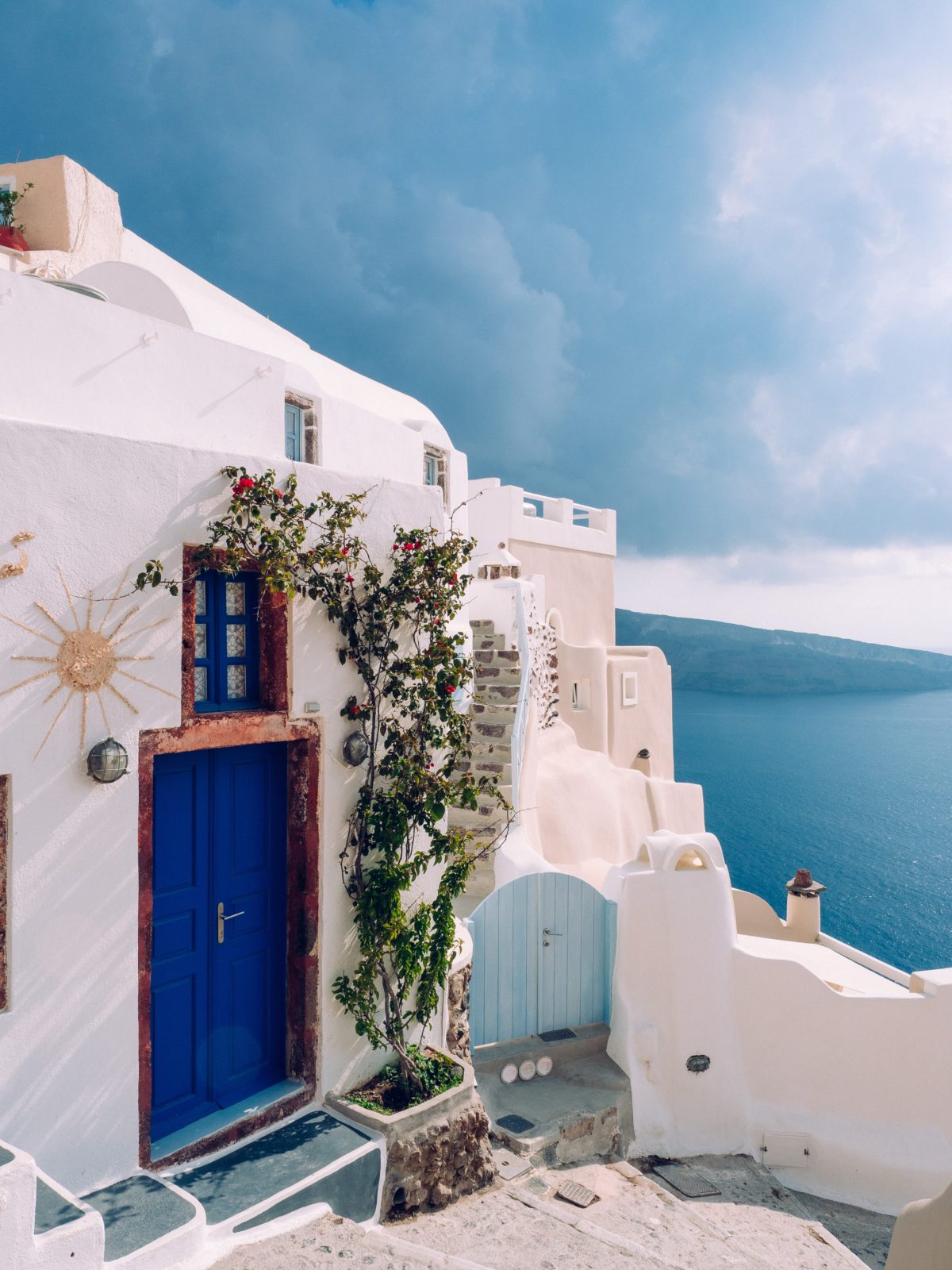
To Ferry Or Not To Ferry?
This one comes with an advanced warning; trying to negotiate ferry routes and schedules can be more painful than encountering the Brazen Bull of ancient Greek folklore. In part, this is down to the sheer number of ferry companies, possible iterations of journey and of course, all those 227 destinations. The paradox of choice can grip you, vice like, in such circumstances.
If you’re familiar with boarding a cruise in the UK, where everything is meticulously organised with clear signage, helpful staff, and orderly queues, prepare for quite a different experience in Greece. Greek ports, particularly during high season, can be chaotic affairs with multiple ferries arriving and departing simultaneously, minimal English announcements, and a somewhat relaxed attitude to published schedules.
As a rule, ferries are most abundant between June and September (the high season). In low season, some routes are simply not do-able. Do be aware that there are no ferries between Crete and Santorini, Santorini and Mykonos, or between Crete and Mykonos, between late November and early March. Athens is, of course, the hub and the easiest place to be based; flights can also be made between the capital and some of the islands.
Equally, there are some occasions in life when you need to pamper yourself, and island hopping in Greece could be the ideal time to splash out a little. Consider renting a private yacht if you’ve got the budget, negating the headache of ferry timetables and turning travel into a pleasure, not a chore.
If you do choose to take the ferry here are our top tips:
- Plan in Advance: Ferry schedules can be complex and routes may change due to the weather. Try to plan your itinerary in detail as far in advance as possible.
- Book Early: During the summer months, Greece is a hugely popular tourist destination. It’s advisable to book your ferry tickets in advance to ensure you get a spot, especially if you’re travelling at peak times.
- Check the Ferry Types: There are several types of ferries, from larger, slower vessels to fast ferries. Slower ferries are generally cheaper but take more time, while fast ferries are more expensive but quicker.
- Arrive Early: Arrive at the port at least an hour before your ferry is set to depart. Greek ports can be chaotic, especially in the summer, and ferries are occasionally early.
- Consider Your Luggage: Some ferries have little space for luggage. If you bring large suitcases, you might have to leave them in a pile on the deck and won’t be able to access them during the voyage.
- Pack Snacks and Water: Smaller ferries may not have cafes or restaurants on board. Pack some food and water, particularly for longer journeys.
- Check the Weather: Weather conditions can significantly affect ferry schedules. Check the weather forecast for your travel day and be prepared for potential delays/cancellations.
- Respect Sea Sickness: If you get seasick, make sure you bring medication. The Aegean can be rough, even in the summertime.
- Confirm Your Destination: Some ferries stop at multiple islands. Make sure you know where and when to get off. It can be helpful to set an alarm for your estimated arrival time.
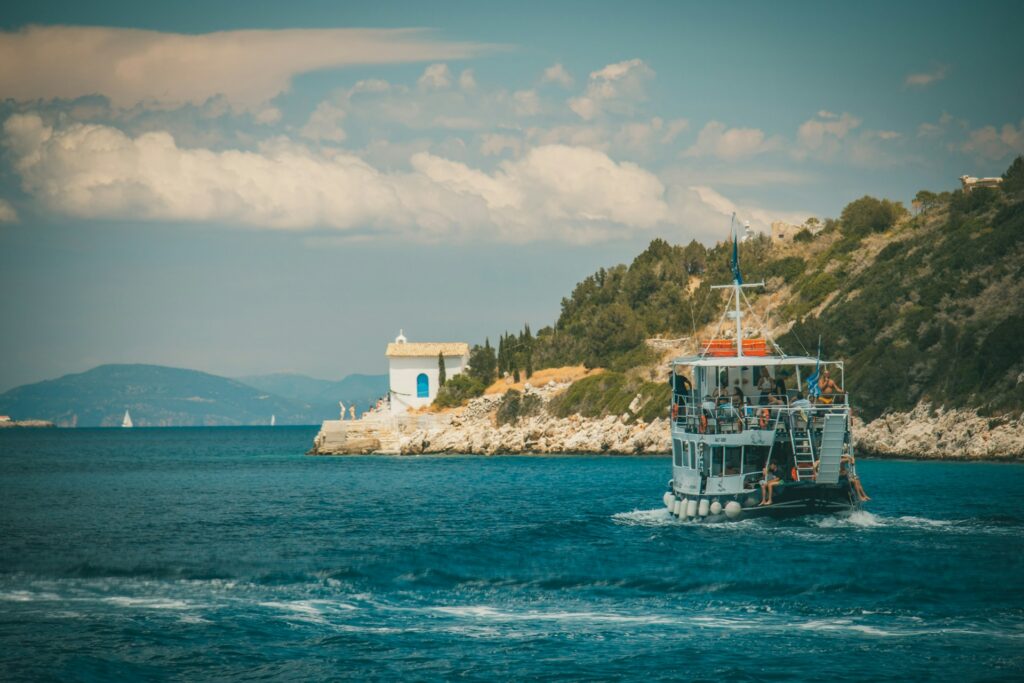
Explore Each Island By Scooter Or Quad Bike
After all the to-ing and fro-ing, hopping and bopping, you’ll want travel autonomy to be in your hands once on terra firma. The sooner you can get mobile, the better, as there’s so much to take in. The best way to keep things loose and leisurely is by renting out a scooter or quad bike at the disembarking point of each destination; easily the best way to get around and take in the spectacular views.
Some of our top tips for renting a scooter or quad bike are…
- Choose the Right Vehicle: Scooters are best for solo travelers or couples, and they’re a great way to get around the islands quickly. Quad bikes are better for groups or families and provide a bit more balance and stability.
- Get the Correct License: Make sure that you have the proper driving license for the vehicle you’re using. An International Driving Permit (IDP) is often required alongside your regular driving license. According to GOV. UK, if you intend to hire a scooter you will need a valid driving licence with at least category A1 – ‘light motorcycle’. Category P, which is valid in the UK for driving mopeds up to 50cc, is not valid in Greece.
- Be Aware of the Terrain: The Greek islands are known for their hilly landscapes, which can pose a challenge for inexperienced drivers. Take it slow, especially when navigating steep or curvy roads.
- Stay Hydrated: The Greek sun can be exceptionally hot, especially during the peak summer months. Make sure to take plenty of water with you.
- Plan Your Route: The Greek Islands can be labyrinthine, and it’s easy to get lost. Plan your route in advance and consider bringing a map or using GPS to avoid getting lost.
- Respect the Environment: Remember that the Greek islands are a natural treasure. Avoid off-roading and other activities that could damage the environment.
- Start Early: It’s best to start your exploration early in the morning to avoid traffic and the midday heat. Plus, you’ll get to enjoy the peaceful ambiance of the islands in the morning.
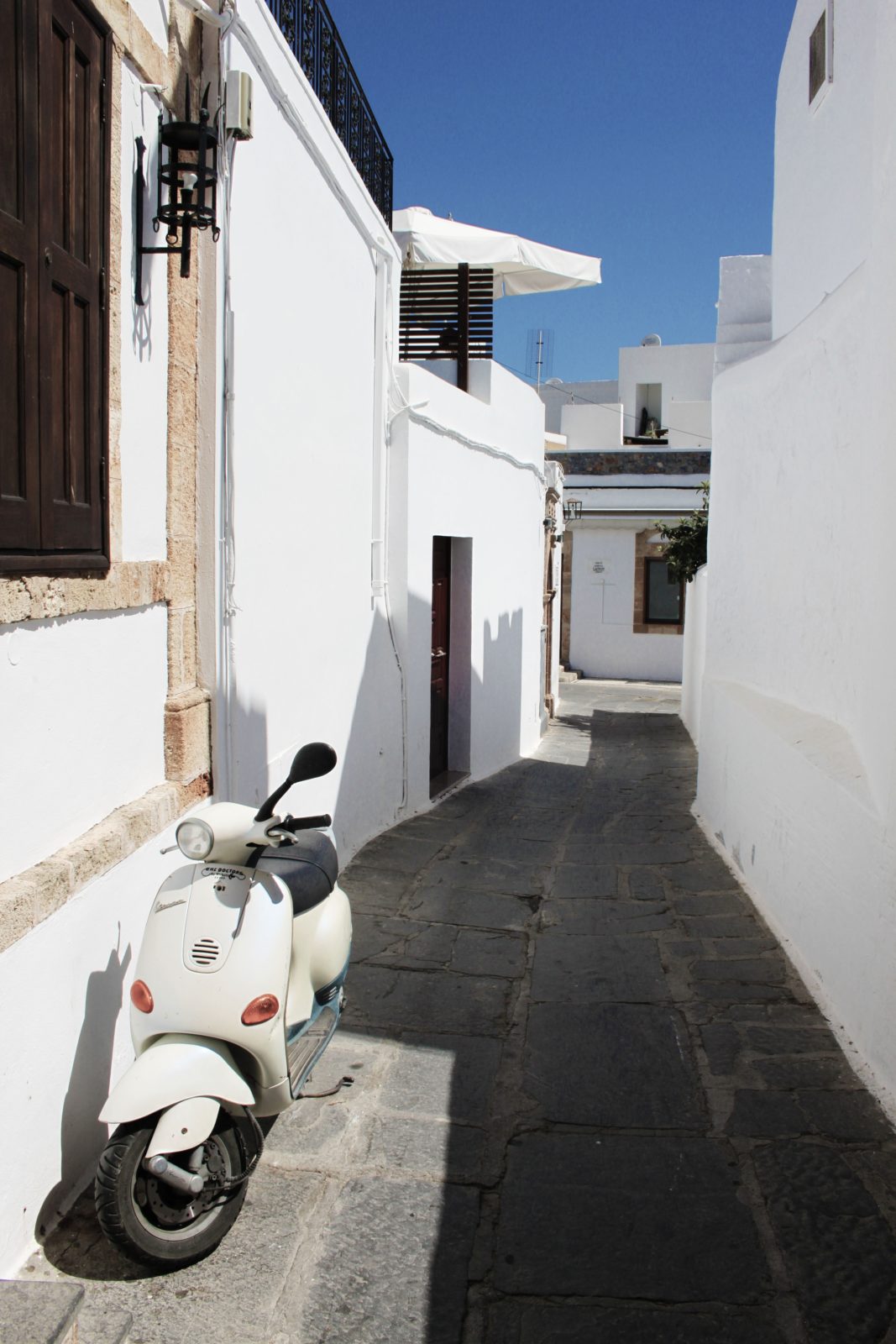
Enjoy The Local Specialities Of Each Island
One of the most rewarding aspects of an island hopping adventure is the amazing diversity of food on offer, with each place specialising in a different plate, utterly unique to their surrounds. Though the terroir may be similar, the taste is not. And that means a journey of culinary discovery awaits.
Crete, the largest island in the Aegean sea, is home to some fine, in-house produced cheese; graviera, anthotiro and ksigalo to name but a few. The island of Sifnos, where legendary Greek chef Nicholaos Tselementes hailed from, calls the splendid lamb and red wine stew Mastela its own.
And everyone’s dream destination Santorini boasts a variety of cherry tomato only grown on the island. Some of the best dishes found here harness this local ingredient’s great power; tomatokeftedes, a kind of tomato fritter, and the island’s very own tomato paste, which is mixed with olive oil, capers and basil and served alongside freshly baked bread, to name but two. Heaven.
It’s important to be aware that Greeks eat late, typically between 8 and 10 pm, and many tavernas and restaurants aren’t open before 7pm. You should get your head around the different type of eateries popular in Greece so you know what you’re getting yourself into before you booking a table. The most typical set for dinner is the taverna, which serves up home-style baked dishes like moussaka and souvlaki (spit-roasted meat).
In the summer months, one of the most popular mezedes is octopus, which you’ll see drying in the sun outside tavernas everywhere. A second very popular style of eating is Mezedopoleio, where small plates of mezes (tapas-style portions of food) are shared in a relaxed, convivial atmosphere, conducive to getting a little merry. Some even serve a round of ouzu with every round of plates. Chin chin!
If you’re after something that won’t give you a hangover, Greece has a fantastic coffee culture too.
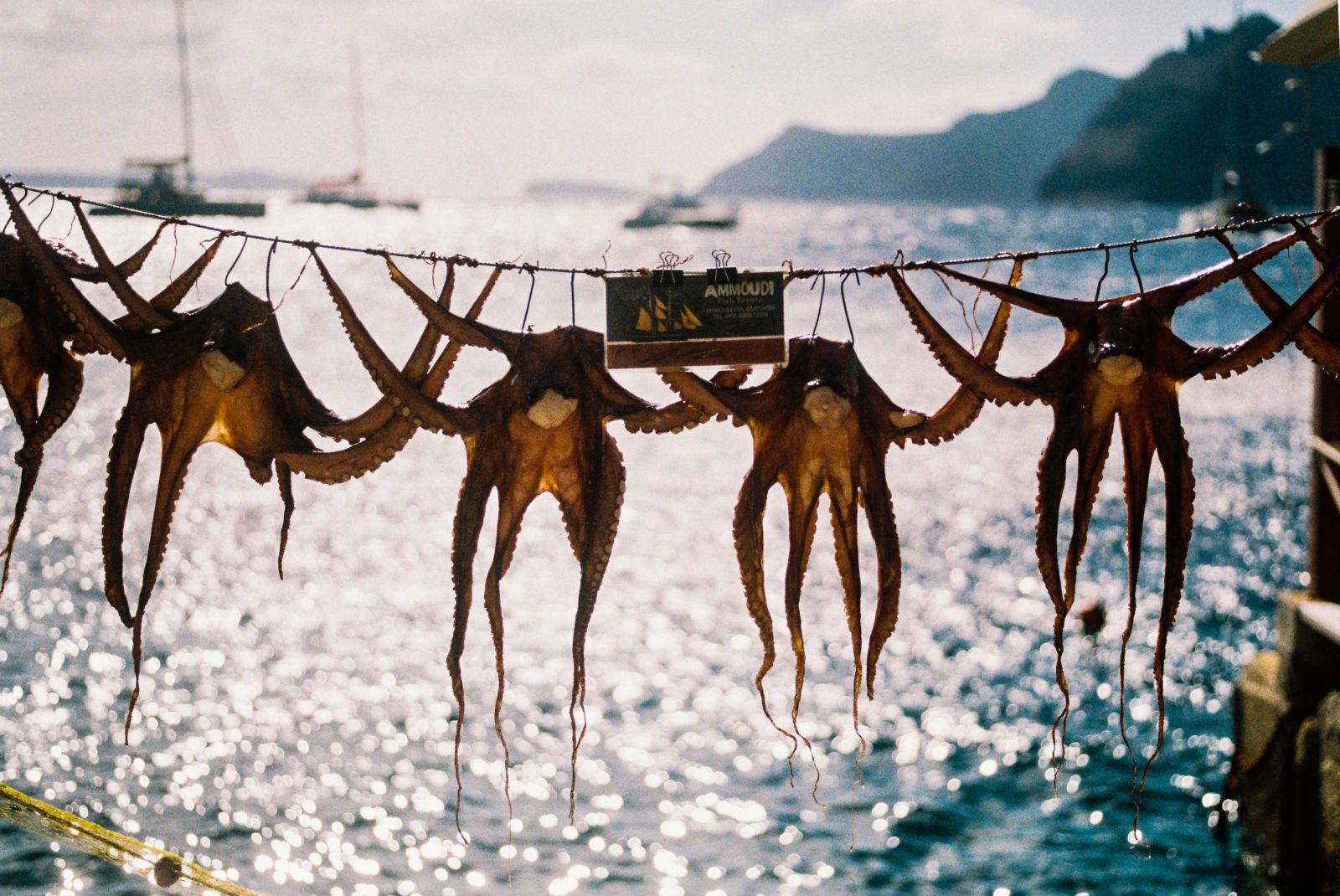
Choose Your Accommodation Wisely
When island hopping in Greece, accommodation choices can make or break your experience. Whilst luxury hotels abound, particularly in tourist hotspots like Santorini and Mykonos, consider venturing beyond the obvious for a more authentic experience.
The traditional Greek ‘domatia’ (private rooms) offer not only a budget-friendly alternative but also a chance to experience genuine Greek hospitality. These family-run joints are often found by simply wandering through village streets, where signs reading ‘Rooms to Let’ beckon travellers. The owners, typically elderly Greeks with limited English but unlimited warmth, can provide invaluable local knowledge that no guidebook could match.
For those seeking a middle ground, boutique hotels nestled in quieter villages offer comfort without the crowds. Many feature stunning terraces with panoramic sea views perfect for enjoying your morning coffee or evening aperitif.
Booking considerations vary seasonally – reserve well in advance for high season (July-August), whilst shoulder seasons allow for more spontaneity. Remember that prime locations with sunset views command premium prices, especially in islands like Santorini, so balance your ‘splurge’ accommodation with more modest options as you hop between islands.
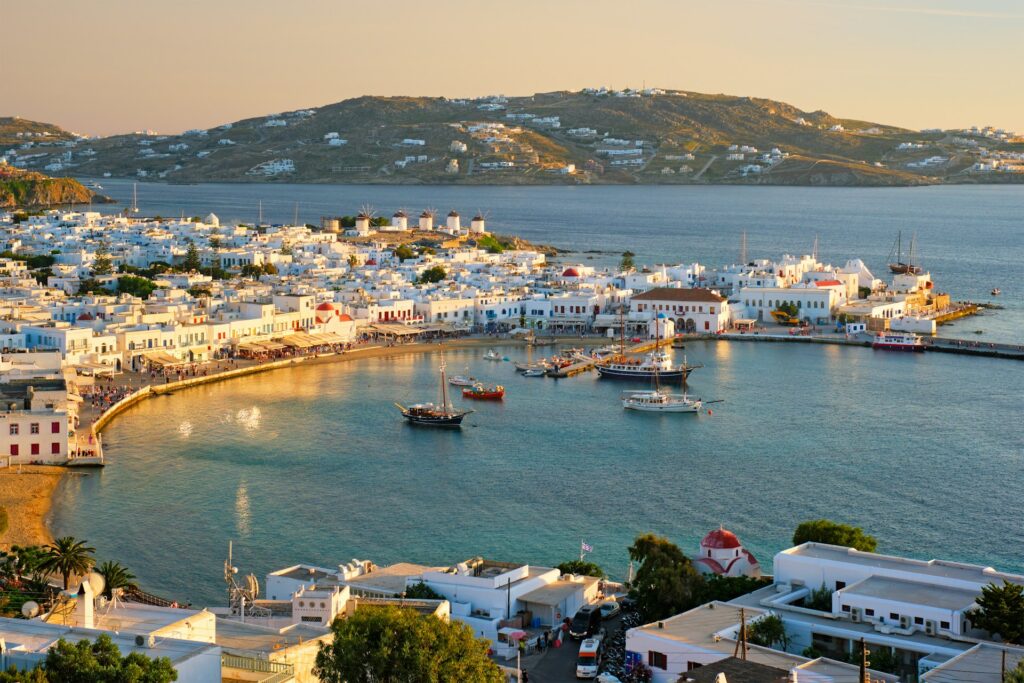
Pack Light But Pack Right
The cardinal rule of island hopping? Travel light. Negotiating ferries, narrow village streets and countless steps becomes infinitely more manageable with minimal luggage. A medium-sized backpack or small wheeled case should suffice for even a fortnight’s adventure.
Essential items include a quality pair of trainers for exploring uneven terrain, alongside proper walking sandals that can transition from beach to taverna. Sun protection is non-negotiable – pack a high SPF sunscreen, a wide-brimmed hat, and quality sunglasses to shield against the fierce Mediterranean sun.
Consider bringing a quick-dry travel towel and snorkelling gear to take advantage of crystal-clear waters without hiring equipment at every stop. A lightweight sarong serves multiple functions – beach blanket, cover-up, and evening wrap when temperatures dip.
Don’t forget a universal adapter, portable power bank, and waterproof phone case. For those prone to motion sickness, pack remedies for potentially choppy ferry crossings. Whilst pharmacies are available on larger islands, they may be limited on smaller ones, so bring any essential medications plus basic first aid supplies.
Remember that many Greek islands have limited ATM access, so carry sufficient euros for smaller establishments that mightn’t accept cards. Lastly, leave room in your luggage for local treasures – from island-made ceramics to bottles of locally-produced olive oil or wine – that will serve as delightful reminders of your Aegean adventure long after you’ve returned home.

Embrace The Siga Siga Lifestyle
We’ve taken ‘hgyye’ to heart, fallen for ‘fika’ and been seduced by ‘siesta’. It’s about time that us Brits embraced Siga Siga, too, meaning slowly slowly. When Greek Island hopping, resetting your watch to a slower pace of life is a must.
No rushing allowed, with the country operating under ‘Greek time’; a casual and laid back interpretation of the very concept of the clock. There’s no grab’n’go culture here, no fighting against life’s merciless tick-tocking, just an appreciation of a gentler pace to life and the benefits it brings. Bliss.
So remember, the key to a successful Greek Island hopping holiday is to take your time, soak up the beauty around you, and embrace the laid-back island lifestyle.





